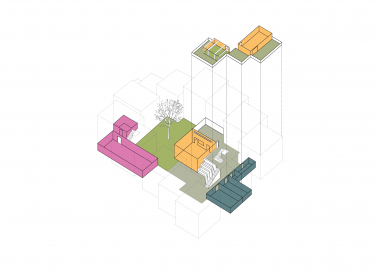Vindmøllebakken
Gaining by Sharing, a housing model concept based on owning less privately but sharing more collectively, forms the underlying framework behind Vindmøllebakken housing community. A project that questions how we build socially sustainable living spaces that reduce our carbon footprint and improve the quality of life.
Vindmøllebakken housing development sits in the Eastern district of Stavanger, a neighbourhood with a diverse mix of historic industrial buildings and traditional timber dwellings. The new proposal combines 40 Co-housing dwellings that share 500m2 of communal space and facilities, with 4 townhouses and 8 apartments also incorporated into the scheme.
The project is constructed from solid timber and orientated in plan around a spacious, internal courtyard and a double height living room that has become the beating heart of the breathing, all-wooden complex. Through an efficient spatial organisation, private living units are minimized with smaller kitchens and bathrooms. Residents therefore gain more access to shared facilities such as a communal kitchen, workshops, library and guest apartments. Residents own less but have access to more.
User participation has been critical throughout the project with the user group being involved from conception through to the design and construction process. A common understanding of community living has been developed among the future residents, but also together with us as the architect. This process has formed and grown alongside the principles of the Gaining by Sharing model, together with Indigo Vekst and Gaia Trondheim. Architectural design choices that support sharing with, and caring for one another’s neighbour, sit at the heart of the project. We believe in the potential of this housing model in creating a more socially sustainable way of urban living by supporting and sharing with one another’s neighbour.
Designed for a diverse mix of resident demographics, different dwelling types are incorporated to suit multiple ages and life situations. Organised spatially around the central courtyard, family rooms and top lit common spaces are located towards the middle of the site. The dwelling units are stepped and shaped around the courtyard and atrium to provide roof terraces and balconies increasing access to natural daylight and ventilation.
The timber structure is formed by diffusion-open pre-fabricated panels with hemp insulation and a 6cm thick solid timber board as the internal finish. This exposed natural surface creates a comfortable indoor climate quality by naturally regulating moisture and emissions. The double height spaces maximise natural daylight into the depth of the plan allowing areas for internal planting to contribute the internal climate quality of the apartments and shared spaces.
Sedum roofs contribute to the natural and green areas within the built environment of the city and create a low maintenance finish to the roofscape. The external landscaping has also been carefully considered with materials from the existing industrial buildings on the site being recycled and re-used. Bricks, concrete beams and roof girders have been incorporated into internal details and finishes and external retaining walls. This holistic approach towards the construction and material composition of the architecture has been as important as to the design as the considerations to the social sustainability at Vindmøllebakken.













